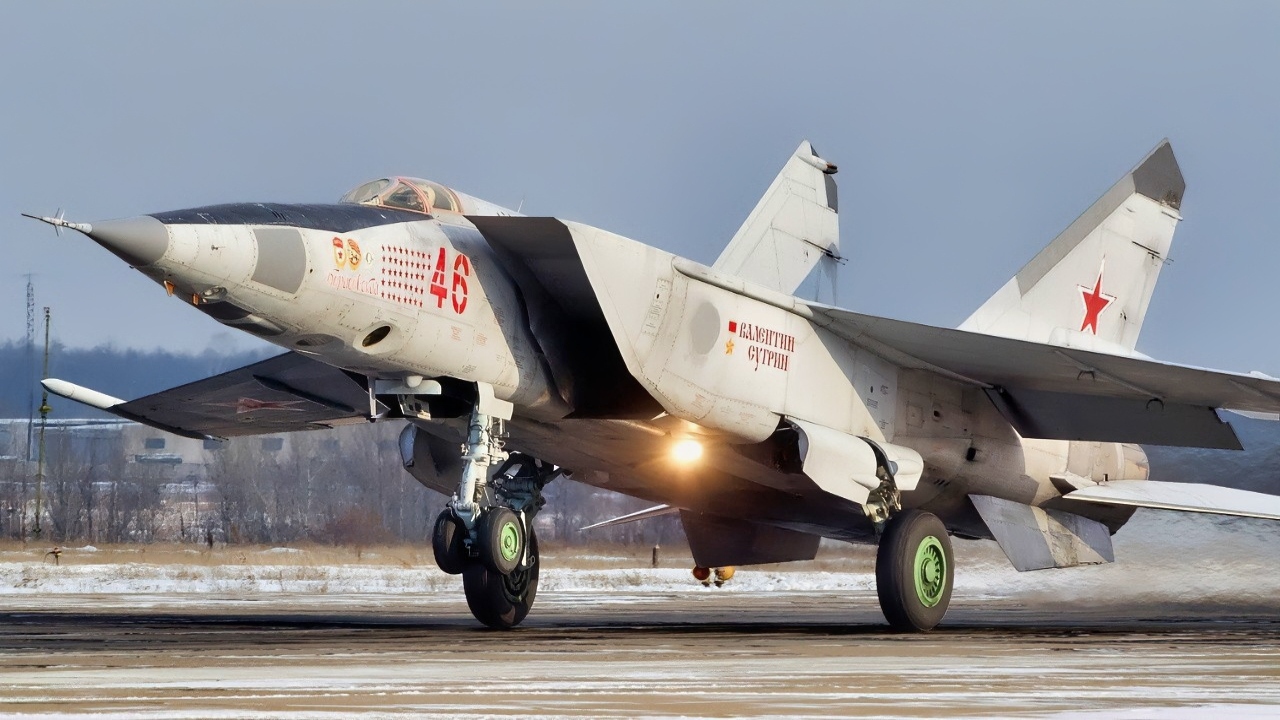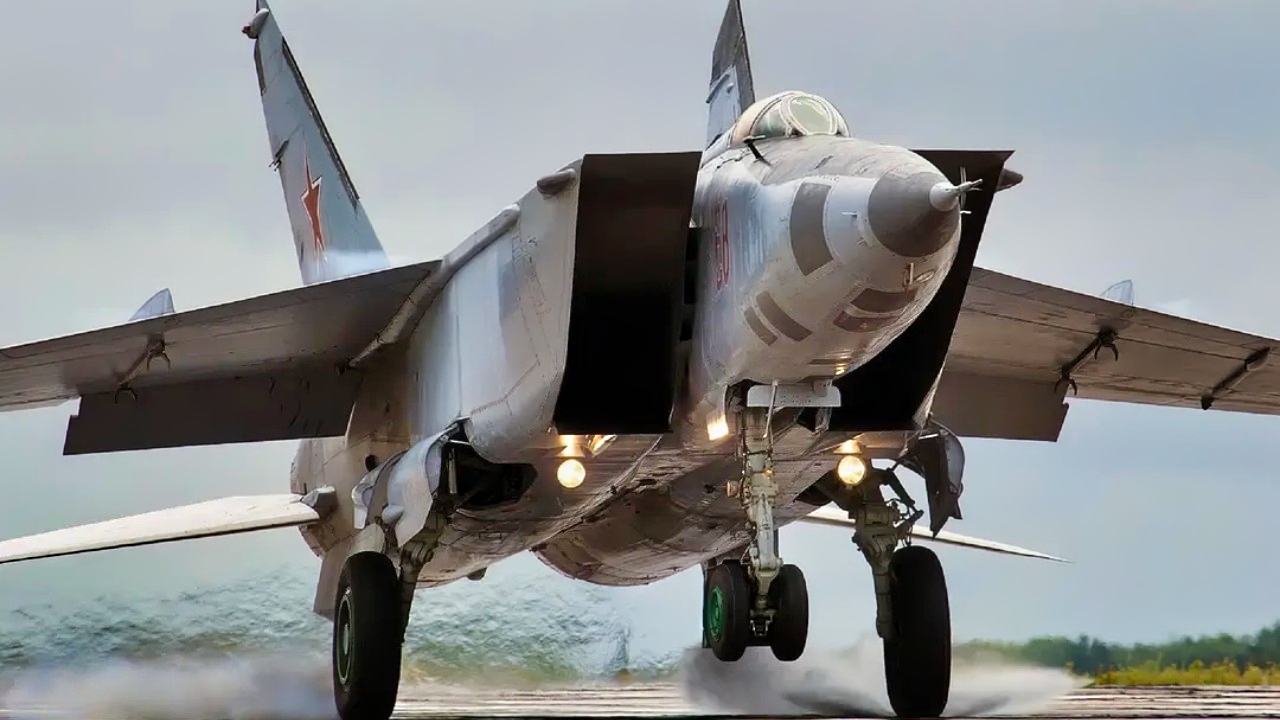Key Points and Summary – The MiG-25 Foxbat was the USSR’s answer to fast intruders: climb hard, sprint high, and intercept before they reached Soviet airspace.
-First flown in 1964, it used two Tumansky R-15s and a mostly stainless-steel airframe to survive skin temps above 300°C and reach Mach 2.8+—occasionally over Mach 3, at the cost of cooked engines.

MiG-25 Taking Off. Image Credit: Creative Commons.
-Optimized for altitude, speed, and long-range R-40 missiles, it was never a dogfighter: heavy, fuel-hungry, and limited in maneuver.
-Variants spanned interceptor, recon/bomber, and SEAD. Though short-lived in frontline glory, the Foxbat’s brutal design philosophy paved the way for the MiG-31’s high-speed, long-range evolution.
The MiG-25 Foxbat Was a Speedy Warplane
The Mikoyan-Gurevich MiG-25 (NATO reporting name: Foxbat) is best known as one of the fastest fighter jets ever built.
Built to counter American reconnaissance planes and strategic bombers, the MiG-25 was first and foremost a high-speed interceptor capable of intercepting high-speed aircraft before they could reach the USSR.
The fighter’s insane speeds are enabled by its high-performance engines, aerodynamic design, and steel hull, which make it more heat-resistant.
Design and Development of the MiG-25 Foxbat
The MiG-25 emerged during a period of intense technological rivalry between the United States and the Soviet Union.
Throughout the 60s, the USSR’s airspace was at risk from U.S. strategic bombers and spy planes like the SR-71 Blackbird. These aircraft were able to fly freely into the USSR and conduct surveillance without fear of being impeded.
To counter this, the Mikoyan design bureau was tasked with creating an interceptor capable of flying at extremely high speeds, reaching altitudes above 20,000 meters, and carrying powerful radar and long-range missiles to destroy high-speed targets.
The result was the MiG-25, which first flew in 1964 and entered service in 1970.

MiG-25. Image Credit: Creative Commons.

MiG-25 Foxbat. Image Credit: Creative Commons.
The MiG-25 featured a large, boxy fuselage and thin, high-aspect-ratio wings optimized for high-speed, high-altitude flight.
Unlike other more maneuverable fighters, the Foxbat was not designed for dogfighting; its mission was to climb fast, accelerate hard, and intercept intruders.
The wings were made of stainless steel and nickel alloys, not aluminum, because aluminum would soften at the extreme temperatures generated by air friction at Mach 3.
About 80 percent of the MiG-25’s structure was stainless steel, 11 percent nickel alloy, and only 9 percent titanium. This was a pragmatic choice as titanium was expensive and difficult to work with, while steel was cheaper and easier to mass-produce.
The Fastest Interceptor Ever Built
Upon its introduction, the MiG-25 was the fastest fighter jet in existence, a title it still holds to this day.
Officially, the aircraft was rated for Mach 2.83, which translates to approximately 3,000 kilometers per hour or 1,860 miles per hour in operational conditions.
However, in practice, it could exceed Mach 3.2 under certain circumstances, though doing so risked severe engine damage.
At Mach 2.8, the MiG-25 could cover 50 kilometers per minute, making it one of the fastest military aircraft ever built, second only to the SR-71 Blackbird in sustained speed.
Despite its breakneck speeds, pilots were instructed not to fly at Mach 3 for extended periods. While the MiG-25 could technically reach such speeds, this was not sustainable.
The aircraft’s Tumansky R-15B-300 turbojets were optimized for high-speed interception rather than prolonged operation at extreme temperatures.
At Mach 3, the engine turbine blades and compressor sections would overheat, leading to catastrophic failure.
There are documented cases where MiG-25 pilots pushed their aircraft beyond Mach 3 during intercept missions. Still, after such flights, the engines often had to be replaced entirely because they were effectively destroyed by thermal stress.
How the Foxbat was Able to Reach Mach 3+
The MiG-25’s ability to reach near-Mach 3 speeds was the result of several key design choices. At its core were two Tumansky R-15B-300 turbojet engines, each producing 11,200 kilograms of thrust with afterburner.
These engines were massive and relatively simple compared to Western designs, prioritizing raw thrust over fuel efficiency or longevity.
At high speeds, the afterburners injected additional fuel into the exhaust stream, dramatically increasing thrust but also consuming fuel at an astonishing rate.
The engines were heavy and had limited lifespan, but they delivered the brute force needed for supersonic interception.
Flying at such high speeds meant the airframe had to withstand intense temperatures.
At Mach 2.8, the aircraft’s skin temperature could exceed 300°C (572°F).
This posed enormous engineering difficulties. Stainless steel was chosen for its heat resistance, even though it made the aircraft extremely heavy, weighing over 36 tons fully loaded.
The MiG-25 also used its fuel as a heat sink to absorb and dissipate heat from critical components, a clever solution to thermal stress.
Legacy and Retirement
Despite what U.S. intelligence thought, the MiG-25 was primarily an interceptor, not a dogfighter.
Its strengths were speed and climb rate (it could reach 20 kilometers altitude in under eight minutes) and its ability to carry long-range missiles, typically the R-40 (AA-6 Acrid), capable of hitting targets at extreme altitudes.
However, it had significant weaknesses. Its heavy steel construction and thin wings made it sluggish in turns, giving it poor maneuverability. Its endurance was limited; at full afterburner, it could drain its fuel in minutes.
Early MiG-25s also had primitive radar and navigation systems compared to Western fighters, reducing their effectiveness in complex combat scenarios.
The MiG-25 served in several roles, including the MiG-25P interceptor variant, the MiG-25RB reconnaissance/bomber version, and the MiG-25BM SEAD (Suppression of Enemy Air Defenses) variant.
Despite its specs, the MiG-25 was discontinued 10 years after its introduction, after over a thousand airframes were built.
The aircraft influenced the development of the MiG-31 Foxhound, which retained high-speed performance while adding advanced avionics and multi-role capability.
About the Author: Isaac Seitz
Isaac Seitz, a Defense Columnist, graduated from Patrick Henry College’s Strategic Intelligence and National Security program. He has also studied Russian at Middlebury Language Schools and has worked as an intelligence Analyst in the private sector.
More Military
Russia’s Mach 2 Su-30SM Fighter Has A Message for Any Air Force on Earth
The Mach 2.2 B-1A Bomber Has A Message for the U.S. Air Force
The Mach 2.35 ‘Super’ Eurofighter Typhoon Fighter Has a Message for Any Air Force On Earth
Canada’s CF-18 Hornet Fighter Crisis
Forget NGAD or the J-20: A 7th Generation Fighter Could Hit Mach 5










